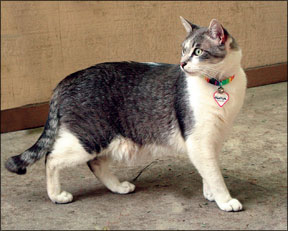When it comes to collars and identification (ID) tags for your cat, youve got a big choice to make. Do you go for color and style, something safe and secure, a name brand, one that costs the least? Because the choices can be overwhelming, heres a guide to why collars are important, how to use collars and ID tags,and what Bev Caldwell 288 CatWatch recommends as being safe. A Collar for Every Cat
As a human companion concerned about your feline, your question should not be if your cat needs a collar – but what type of collar your cat needs. All cats need a collar and an ID tag. That may come as a surprise to you if you keep your cat indoors. But many lost cats were indoor cats at the time they went missing. “Almost half the people who have lost a cat never expected their indoor-only cat to get outside,” says Brenda Griffin, DVM, MS, with the Department of Population Medicine and Diagnostic Sciences of Cornell University’s College of Veterinary Medicine. Indoor cats get frightened and bolt out of the house, a guest leaves the door open accidentally, your family must vacate the house in an emergency or natural disaster. Anything can happen. An indoor cat that finds itself outside is particularly vulnerable to getting lost and becoming a stray because its not used to being outdoors and finding its way home. Whatever scared your cat in the first place may cause your cat to stay in hiding, not come home or prevent you from finding it.
“We strongly encourage people to collar their cats – even if theyre strictly indoor cats,” says Brenda Griffin, the veterinarian in charge of initiatives to promote pet ID for both cats and dogs at Cornell University. “We consider an ID collar an essential component of a wellness program for all pet cats (wellness equals preventive medicine).”
Outdoor cats are as easily lost. People may think a cat doesnt belong to anyone and may take the cat away from the area. A collar immediately signifies that a cat has a home.
If the unthinkable happens and your cat – indoor or outdoor – gets lost, the chances of your cat being found and returned to you are infinitely higher if your cat is wearing some form of ID.
But even then – a collar and ID isnt enough. Because a collar and ID may fall off, your cat also needs to be micro-chipped. The best option to ensure the safety of your cat is to have your cat micro-chipped and also wear a collar and ID. Says Dr. Griffin, “Think of it as a safety belt and an airbag! A collar with a tag serves as a visible form of ID and tells anyone who finds your cat that he/she is not a stray. The microchip is a very important backup form of identification. If the collar and tag are lost and your pet ends up in an animal shelter or veterinary clinic, the invisible microchip can be detected with a scanner.”
Its critical to be sure that the microchip is registered with a national microchip database, she says, so that your contact information is lined to your cats microchip number. This will ensure that the shelter or clinic that finds your cat can successfully locate you.
Will Your Cat Wear It?
Many folks buy into the idea that cats cant wear collars, but most can, says Dr. Griffin. If you start your kitten wearing a collar, she will grow up used to it. However, you can start an adult cat wearing one, too. It may take a few days to get used to, but if you consistently keep the collar on your cat, your feline will adapt. If the collar has a bell on it, your cat may look around for the first day, trying to find out where that jingling is coming from. But even that is something that your cat will accept.
So what collar should you buy? There are many types available in pet shops, online and even in the pet sections of supermarkets. Many collars are purely cosmetic – designed with “jewels” or to hold charms. However, the main purpose of a collar is to hold an ID tag.
“We tend to recommend safety collars because theyre designed to break away should the kitty get the collar caught on something,” says Dr. Griffin. These breakaway collars are designed with a link or buckle that will release once a certain amount of pressure is applied to them. According to www.lupinepet.com, the release point for their cat safety collar is approximately five pounds of pressure. (There are also safety collars which claim to stretch if they get caught on something, but the consensus seems to lean toward the breakaway collar as the safest.)
Here are some tips for fitting and using a collar correctly:
- Dont use a collar and a lead as a harness to walk your cat. Similarly, dont use a collar and lead to tie up your cat outside.
- When fitting a breakaway cat collar, it should be snug enough to resist pulling over the cats head. “If its too loose, the cat may be able to get its jaw or paw under the collar and release the buckle,” according to www.lupinepet.com. A cat that scratches at the collar may snag the D-ring or the webbing, possibly forcing the buckle.
- Remember that kittens grow quickly! If your get your kitten a collar, buy an adjustable one or make sure you check the fit frequently. Its a good idea to go to the pet shop for help fitting your cat for a collar.
- Most collars can be machine-washed, but be careful of putting nylon collars in the dryer because they may shrivel up.
- Make sure the collar doesnt fray because fraying may cause the collar to tighten up, especially if your cat snags a thread with its claw.
- If your cat goes outside, get a collar with a bell that may scare away birds. And a bell will help you locate your cat in a big house.
- Remove the collar when grooming your cat, especially if your cat is long-haired.
Each year, its estimated that millions of people lose a pet. “Dont let that be you!” says Dr. Griffin. “Providing your cat with both an ID tag and a microchip is good medicine and a proactive, preventive measure to greatly enhance the chances of finding your beloved cat should it become lost.”



